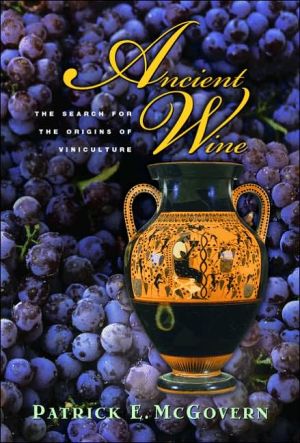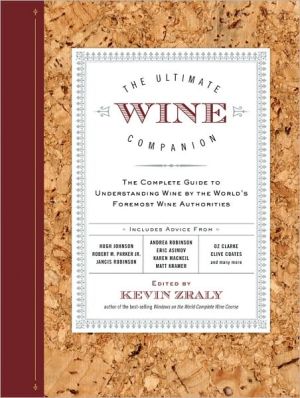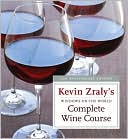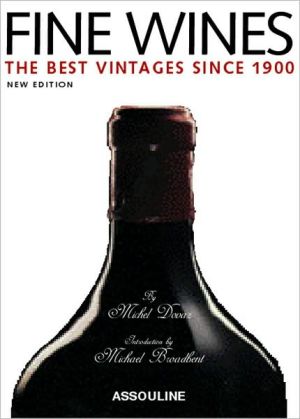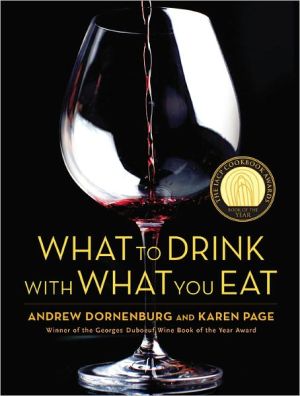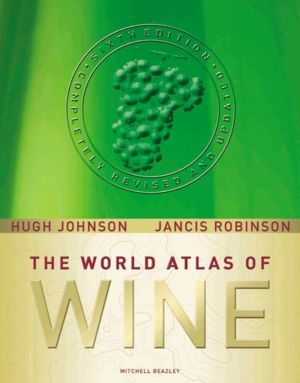Ancient Wine: The Search for the Origins of Viniculture
The history of civilization is, in many ways, the history of wine. This book is the first comprehensive and up-to-date account of the earliest stages of vinicultural history and prehistory, which extends back into the Neolithic period and beyond. Elegantly written and richly illustrated, Ancient Wine opens up whole new chapters in the fascinating story of wine and the vine by drawing upon recent archaeological discoveries, molecular and DNA sleuthing, and the texts and art of long-forgotten...
Search in google:
"I raise my glass to Patrick McGovern, who mixes authoritative knowledge of ancient viniculture with inspired writing into a heady drink for the mind. This is a beautifully written book, full of insight into the origins, culture, and economy of wine."--Roald Hoffmann, Cornell University, 1981 Nobel Laureate in Chemistry"Patrick McGovern serves us a magnificent feast of science and history that melds sophisticated chemistry with good, old-fashioned historical sleuthing. His innovative research has revolutionized our knowledge of the origins of one of humanity's greatest pleasures. This is an archaeological and gustatory delight for specialist and general reader alike."--Brian Fagan, University of California, Santa Barbara, author of The Little Ice Age"Ancient Wine tells a dramatic, factual story of wine's beginnings at the dawn of civilization 8,000 years ago, bringing to life what I have long believed-wine has been an essential part of the gracious way of life for many cultures. Patrick McGovern takes us on a fascinating journey back to the first experiments in making this marvelous beverage. He shows the central role of wine in human history, with insights drawn from archeology, chemistry, gastronomy, and the arts. Ancient Wine will please everyone who enjoys wine. I heartily recommend it."--Robert Mondavi, winemaker"What a great book! Patrick McGovern takes us along for the ride as he searches for the origins of modern wine. This is a very personal, engagingly written story, and we're privileged to watch over McGovern's shoulder as he unravels the mysteries of ancient vines and wines."--Rod Phillips, author of A Short History of Wine"Told with enthusiasm and verve, Ancient Wine is an illuminating discussion of an important area of research. It represents a substantial contribution to our understanding of the nature of consumption in early urban societies, and draws together investigations of some of the outstanding pieces of evidence that are of prime relevance to the story."--Andrew Sherratt, author of Economy and Society in Prehistoric Europe J. Madeleine Nash - Time Magazine No one is better qualified to sift through the widely scattered clues [to the origins of winemaking] than McGovern, a skilled scientific sleuth who wields the most powerful tools of modern chemistry in his search for the roots of ancient wines.
Ancient Wine\ The Search for the Origins of Viniculture \ \ By Patrick E. McGovern \ Princeton University Press\ Princeton University Press\ All right reserved.\ ISBN: 0-691-07080-6 \ \ \ Chapter One\ STONE AGE WINE \ A SINGLE Eurasian grape species (Vitis vinifera L. subsp. sylvestris), among approximately 100 that grow wild in temperate zones of Asia, Europe, and North America, is the source of 99 percent of the world's wine today (color plate 1). We may call the vine a Cabernet Sauvignon, a Gewürztraminer, or a Shiraz cultivar. We may be impressed by the varietal wines that are produced from the fruit of these vines, whether a dense red color, redolent of blackberries and cedar, or a flinty white with a hint of straw. The fact remains that we owe the seemingly infinite range of color, sweetness, body, acidity, taste, and aroma of this delectable beverage to one grape species.\ The predominance of the Eurasian grapevine is all the more remarkable because the ancient inhabitants of the regions in which numerous wild grape species thrive today-China and North America, in particular-do not appear to have exploited the grapevine as a food source or to have brought it into cultivation. Leif Eriksson and his Viking compatriots were impressed enough by the proliferation of grapevines throughout the northeastern forests of the New World to call it Vinland. Yet, except for the occasional grape seed from anancient village or encampment, there is as yet no archaeological evidence that Native Americans collected the wild grape for food, let alone domesticated the plant and made wine from its fruit.\ Ancient Chinese sites are thus far similarly devoid of grape remains, although that picture is changing as more sophisticated techniques are used (see chapter 12). The earliest literary reference to wine in China is the account of General Zhang Qian, who traveled to the northwestern fringes of the Western Han realm in the late second century B.C. He reported that there (in the modern province of Xinjiang), astride the Silk Road, and farther along in Bactria and Sogdiana in Uzbekistan whose grapes were already legendary in the West, the most popular beverage was wine. Indeed, in the fertile valley of Fergana on the western side of the Pamir Mountains, the wealthiest members of the society stored thousands of liters of grape wine, aging it for a decade or more. Zhang was so impressed with the beverage that he brought cuttings back to the imperial palace, where they were planted and soon produced grapes whose juice was made into wine for the emperor. Zhang's vines, however, did not belong to any East Asian species, such as Vitis amurensis with its huge berries growing along the Amur River in Manchuria, but to the Eurasian grape species, Vitis vinifera.\ How can the Eurasian grape's dominant position in the world of wine be explained? Vitis labrusca and Vitis rotundifolia (the latter also known as scuppernong or muscadine) eventually established footholds as wine grapes in the New World, despite their foxy or sour undertones and a cloying sweetness that seemed better suited to a Concord jelly than a Niagara or Manischewitz wine. By crossing an American species with the Eurasian species, experiments that were promoted by Thomas Jefferson and others, varieties that produce quite good wines were eventually established in Virginia and in the southeastern United States. In China, grapes with high residual sugar, such as Vitis amurensis, which can be further enhanced by raisining, can also produce a decent wine. But again, the Eurasian grape was crossed with Chinese species in recent centuries to provide the impetus for developing a native industry.\ Sifting Fact from Legend\ To understand why and how the Eurasian grapevine is central to the story of wine, we must travel back to a period in human prehistory shrouded in the mists of time. Barring time travel, would-be interpreters of the past are trapped within the fourth dimension. Time's arrow is pointed in one direction, and our task is to peer back millions of years and reconstruct the series of unique events that led to the domestication of the Eurasian grape and wine.\ Archaeology-the scientific study of ancient remains-will be our principal resource and guide in proposing a plausible scenario for Stone Age wine. Ancient records provide no signposts in this quest, because the earliest written texts, dating to about 3500 B.C., are much later and consist of brief, often cryptic records. Extensive treatises on wine-such as chapter 14 of Pliny the Elder's Historia naturalis (Natural History), written in the first century A.D.-are only as good as the writer's sources or experience and are refracted through the Weltanschauung of the time.\ As intriguing and often exciting as the stories of the origins of viniculture (encompassing both viticulture-vine cultivation-and winemaking) are, this tangled "vineyard" needs to be trod with caution. Many books on the history of wine give undue weight to one legend or another and rely on dubious translations. If ancient Greek writers variously state that Dionysos, the Greek god of wine, came from Phoenicia, Crete, Thrace, Lydia, or Phrygia, one must plumb deeper. Another widespread view, shared by many ancient Mediterranean cultures, was that the vine sprang from the blood of humans who had fought against the gods.\ A Persian tale of a king Jamsheed, otherwise unknown in that country's dynastic history, is very endearing. The monarch was fond of fresh grapes and stored them in jars to have a year-round supply. One consignment unfortunately went bad, and the jar was labeled as poison. Suffering from severe headaches, a harem consort then mistakenly drank from the jar and fell into a deep sleep, to awake miraculously cured. She informed the king of what had happened, and, in his wisdom, he discerned that the "poison" was actually fermented grape juice or wine with medicinal effects. He then ordered more such poison to be prepared, and thus humanity embarked upon its ages-long wine odyssey.\ The Jamsheed story says nothing about how a mass of solid grapes could have fermented into a liquid beverage. Was the same procedure followed to make subsequent batches? There is also no mention of the domestication of the grapevine and vineyard management. In short, it is a simple tale, floating somewhere in time, like many other origin legends. If its historical details are suspect, it cannot be a basis for inferring that Iran is the homeland of winemaking, as has been done.\ Archaeology, together with other historical sciences dealing with geology and plant remains (paleontology and archaeobotany), is able to provide a better starting point for hypotheses about the beginnings of viniculture than ancient texts. Despite its narrow database and mute testimony, archaeological evidence has a powerful explanatory dimension. There is no hidden bias lurking in a pottery sherd or a stone wall, as there might be in a written document. The archaeological artifact or ecofact (a term for a natural object, unmodified by humans, such as a grape seed or vine) is there because it played a role in the life of the community or was incorporated into the deposit by some other natural agency. It represents unintentional evidence that is contemporaneous with the events that one seeks to explain.\ A host of scientific methods-ranging from radiocarbon dating to high-resolution microscopy to DNA analysis-can now be used to extract the maximum amount of information from archaeological remains. Increasingly, minuscule amounts of ancient organics, sometimes deriving from grapes or wine, have a story to tell.\ Sufficient archaeological excavation has now been carried on around the world to reveal that human beings, given enough time, are remarkably adept at discovering practical and innovative solutions to life's challenges. Beginning as small bands, increasingly complex societies developed and led to the earliest civilizations of the world-those in the Middle East, East Asia, South Asia, and Meso-america and Peru in the New World. Although sporadic interactions between these regions might have occurred from time to time, their writing systems, monumental architecture, arts, and technologies are largely explainable within their own contexts.\ One example of human innovation that occurred in different regions is purple dyeing. It was most likely independently discovered by humans living along the coasts of the Mediterranean Sea and on the western and eastern shores of the Pacific Ocean in China and Peru. The intense purple dye has only one source in nature: chemical precursors of the indigoid compound (6,63-dibromoindigotin) contained in the hypobranchial glands of certain marine mollusks. These animals, variously assigned to the genera Murex, Concholepas, Thais, and Purpura, among others, live in saltwater bodies around the world. Somehow, beginning as early as 1500 B.C. in the Mediterranean region, probably somewhat later in China, and about 700 B.C. in Peru, human beings discovered by extracting the glandular contents in quantity and exposing the liquid to light and air enabled them to produce this unique color for dyeing textiles and other materials. Because it requires as many as 10,000 animals to produce a gram of the dye, it was very expensive to make. In each civilization, the molluscan purple dye eventually came to be associated only with the highest political authorities and was imbued with special religious significance. In first-century Rome, Nero issued a decree that only the emperor could wear the purple-hence, the name Royal Purple.\ Some observers might argue that a transference of dyeing technology from a more advanced culture (e.g., the Near East) to a more fledgling one (China or Peru) accounts for the available evidence. Some might even go so far as to invoke a deus ex machina or extraterrestrial visitors. Another scenario is more likely for this example of convergent development, in keeping with Occam's razor or rule (the simplest, most straightforward explanation is often the right one). It runs as follows. The mollusks with the purple dye precursors were probably also a source of food in each region. The Mediterranean species, for example, are still a great delicacy in France and Italy, and the Chinese are renowned for exploiting every food source in their environment. When the animal is removed from its shell in preparation for eating, the hypobranchial gland, which is located on the outside of the creature, is easily broken. Once the liquid has seeped out, it will immediately begin to change from greenish to purple. A shellfish-monger's hands would soon be covered with the purple dye, which is one of the most intense natural dyes known and can be removed only by using a reducing agent. By no great leap of imagination, people began to collect the purple and use it as a dyeing agent. Although this scenario may never be proved absolutely, it accounts for the archaeological data and is in keeping with human inventiveness.\ Food is a basic necessity of human life. It is also one of life's main pleasures and serves many auxiliary roles in medicine, social interactions, and religious symbolism. Just as people probably discovered the famous purple dye in the process of exploiting a food resource, humans have long been in search of that strange or exotic taste, texture, or aroma that will stimulate their senses, provide a sense of well-being, or even elevate them to metaphysical heights. Food is thus much more than simple nourishment, taken three times a day to survive. Because humans are omnivores who came on the world scene relatively late in the earth's evolution, they had an enormous range of plants and animals from which to choose. Yet they had to be willing to explore their environment and experiment to discover the delectable foods and beverages awaiting them, as well as to avoid danger.\ Man Meets Grape: The Paleolithic Hypothesis\ The wild Eurasian grapevine (Vitis vinifera L. subsp. sylvestris) grows today throughout the temperate Mediterranean basin from Spain to Lebanon, inland along the Danube and Rhine Rivers, around the shores of the Black Sea and the southern Caspian Sea, at the headwaters of the Tigris and Euphrates Rivers, and farther east in the oases of Central Asia. This distribution is likely only a shadow of what prevailed some 50 million years ago in warmer times, leading up to the most recent Ice Age in Quaternary times, starting about 2.5 million years ago. Pockets of the wild Eurasian grape managed to survive the four cold, dry spells of this Ice Age in lower-lying valleys and plains.\ Fossil seeds and leaf impressions of the family Vitiaceae, including the American, Eurasian, and Asian groups, shared more physical features during the late Tertiary period, 50 million years ago, than now. Possibly, this plant even traces its ancestry back much earlier-to Ampelopsis, a climbing vine of 500 million years ago. With the breakup of the single landmass (Pangaea) and a gradual distancing of the continents from one another, however, the individual groups emerged. More recently, increasing desertification in Central Asia, North Africa, and North America and other natural barriers have isolated populations and led to the approximately 100 modern species thus far described.\ Just as they were with the mollusks and their purple dye, humans certainly would have been acquainted with the wild Eurasian grapevine and its peculiar fruit at a very early date. Groups of human beings (Homo sapiens) migrated from East Africa about 2 million years ago, across the natural land bridge of the Sinai Peninsula into the Middle East. Their first encounter with the wild grape might have been in the upland regions of eastern Turkey, northern Syria, or northwestern Iran. Perhaps they saw the plant in a more southerly locale-the Hill Country of Palestine and Israel or the Transjor-danian Highlands-because of moister conditions prevailing during interglacial periods than at present.\ The general framework that brings human and grapevine together for the first time in the Paleolithic period also leads to a set of postulates about the discovery of wine, which is conveniently referred to as the Paleolithic Hypothesis. It was seriously entertained and debated at a watershed conference titled "The Origins and Ancient History of Wine" at the Robert Mondavi Winery in 1991 (see chapter 3).\ One can imagine a group of early humans foraging in a river valley or upland forest, dense with vegetation, at some distance from their cave dwelling or other shelter. They are captivated by the brightly colored berries that hang in large clusters from thickets of vines that cover the deciduous or evergreen trees. They pick the grapes and tentatively taste them. They are enticed by the tart, sugary taste of the grapes to pick more. They gather up as many of the berries as possible, perhaps into an animal hide or even a wooden container that has been crudely hollowed out. A hollow or crevice in the rock might also serve the purpose. Depending on the grapes' ripeness, the skins of some rupture and exude their juice, under the accumulated weight of the grape mass. If the grapes are then left in their "container," gradually being eaten over the next day or two, this juice will ferment, owing to the natural yeast "bloom" on the skins, and become a low-alcoholic wine. Reaching the bottom of "barrel," our imagined caveman or -woman will dabble a finger in the concoction, lick it, and be pleasantly surprised by the aromatic and mildly intoxicating beverage that has been produced accidentally. More intentional squeezings and tastings might well ensue.\ Other circumstances could have spurred on the discovery. Many animals, especially birds, have a fondness for grapes, probably as a result of their having occupied the same ecological niches as the grapevine since at least the Tertiary period. Under the right climatic conditions, grapes will ferment on the vine. The berries are attacked by molds, which concentrate the sugar and open up the grape to fermentative attack by the natural yeast, to yield an even higher alcoholic product than normal. As an aside, the deliberate use of a mold to a make a late-harvest, ambrosia-like wine had to wait another million years or more, when in the late seventeenth and eighteenth centuries A.D. both the Hungarians at Tokay and the Germans in the Rheingau took credit for discovering noble rot (Botrytis cinerea).\ (Continues...)\ \ \ \ \ Excerpted from Ancient Wine by Patrick E. McGovern Excerpted by permission.\ All rights reserved. No part of this excerpt may be reproduced or reprinted without permission in writing from the publisher.\ Excerpts are provided by Dial-A-Book Inc. solely for the personal use of visitors to this web site. \ \
List of IllustrationsPreface1Stone Age Wine12The Noah Hypothesis163The Archaeological and Chemical Hunt for the Earliest Wine404Neolithic Wine!645Wine of the Earliest Pharaohs856Wine of Egypt's Golden Age1077Wine of the World's First Cities1488Wine and the Great Empires of the Ancient Near East1679The Holy Land's Bounty21010Lands of Dionysos: Greece and Western Anatolia23911A Beverage for King Midas and at the Limits of the Civilized World27912Molecular Archaeology, Wine, and a View to the Future299Selected Bibliography317Illustration Credits and Object Dimensions329Index335
\ Philadelphia InquirerIt's obvious that McGovern has a passion for his research, and that his deep appreciation for wine is enhanced by his understanding of wine's role in civilization. Wine lovers who also enjoy delving into wine's rich history will find much to savor in this complex but intriguing book.\ — Deborah Scoblionkov\ \ \ \ \ CulturekiosqueMr. McGovern is an exceptional scholar who employs a lively narrative and the latest techniques in scientific archaeology and historiography to help the contemporary reader peer into the most remote corners of early man's agricultural and ritual past. What we learn there is simply riveting. And while the book was first published in 2003, it remains a brilliant and at times prescient work which no civilised amateur of fine wines or modern wine cultures should be without.\ — Joseph Romero\ \ \ European LegacyExcellent maps and illustrations, many in full color, enrich the presentation. . . . The price of the new paperbound edition is reasonable, even astonishing given the color plates, and should make it so much the easier for those interested in ancient history, in wine, or in both to acquire and savor it.\ — Victor Castellani\ \ \ \ \ New YorkerA remarkable new book.\ \ \ \ \ Time MagazineNo one is better qualified to sift through the widely scattered clues [to the origins of winemaking] than McGovern, a skilled scientific sleuth who wields the most powerful tools of modern chemistry in his search for the roots of ancient wines.\ \ \ \ \ Natural HistoryA rich treasury of lore on viticulture. . . . McGovern's book will likely remain a standard in every serious wine-lover's library for a long time. To that achievement—and to glorious wine itself—let us raise our glasses high.\ \ \ \ \ American ScientistIt takes nerve to tackle a subject as wide-ranging in chronology, geography and historical variability as the study of ancient viniculture, and it takes rhetorical flourish to make such a study riveting, informative and thought-provoking. Patrick McGovern has succeeded in doing just that. His Ancient Wine is a book to be highly recommended to lay and professional audiences alike.\ \ \ \ \ Philadelphia InquirerIt's obvious that McGovern has a passion for his research, and that his deep appreciation for wine is enhanced by his understanding of wine's role in civilization. Wine lovers who also enjoy delving into wine's rich history will find much to savor in this complex but intriguing book.\ \ \ \ \ New StatesmanThis is a prodigiously learned book by a prodigiously learned man. . . . McGovern uses wine as a vehicle for exploring the reaches of ancient history, and for presenting some of the astonishing archeological discoveries that are still being made. . . . By the time we get to Persia, Greece and Rome it has become truly urgent, because it is now a story of civilizations and their clashes—the story in which we are still involved.\ \ \ \ \ New England Wine GazetteThis book is clearly written, generously illustrated, and thoroughly indexed.\ \ \ \ \ BellaOnlinePrinceton University Press has published the definitive book on grape and wine history. Ancient Wine by Patrick E. McGovern is history writing at its best. Thoroughly engaging, this is beautifully illustrated with photos of historical artifacts.\ \ \ \ \ Heritage Key[W]ine lovers who want to discover more of the origins of their favourite drop will find Ancient Wine of great value and interest.\ \ \ \ \ CulturekiosqueMr. McGovern is an exceptional scholar who employs a lively narrative and the latest techniques in scientific archaeology and historiography to help the contemporary reader peer into the most remote corners of early man's agricultural and ritual past. What we learn there is simply riveting. And while the book was first published in 2003, it remains a brilliant and at times prescient work which no civilised amateur of fine wines or modern wine cultures should be without.\ \ \ \ \ European LegacyExcellent maps and illustrations, many in full color, enrich the presentation. . . . The price of the new paperbound edition is reasonable, even astonishing given the color plates, and should make it so much the easier for those interested in ancient history, in wine, or in both to acquire and savor it.\ \ \ \ \ New YorkerA remarkable new book.\ — Adam Gopnik\ \ \ \ \ Time MagazineNo one is better qualified to sift through the widely scattered clues [to the origins of winemaking] than McGovern, a skilled scientific sleuth who wields the most powerful tools of modern chemistry in his search for the roots of ancient wines.\ — J. Madeleine Nash\ \ \ \ \ Natural HistoryA rich treasury of lore on viticulture. . . . McGovern's book will likely remain a standard in every serious wine-lover's library for a long time. To that achievement—and to glorious wine itself—let us raise our glasses high.\ — Laurence A. Marschall\ \ \ \ \ American ScientistIt takes nerve to tackle a subject as wide-ranging in chronology, geography and historical variability as the study of ancient viniculture, and it takes rhetorical flourish to make such a study riveting, informative and thought-provoking. Patrick McGovern has succeeded in doing just that. His Ancient Wine is a book to be highly recommended to lay and professional audiences alike.\ — James C. Wright\ \ \ \ \ Toronto StarThe most fascinating scholarly wine book this year. . . . This is a tapestry woven from surviving cultural fragments and combines art, archeology, chemistry and gastronomy. It tracks the thread of wine through 8,000 years of human history and is not for the faint-hearted.\ \ \ \ \ New StatesmanThis is a prodigiously learned book by a prodigiously learned man. . . . McGovern uses wine as a vehicle for exploring the reaches of ancient history, and for presenting some of the astonishing archeological discoveries that are still being made. . . . By the time we get to Persia, Greece and Rome it has become truly urgent, because it is now a story of civilizations and their clashes—the story in which we are still involved.\ — Roger Scruton\ \ \ \ \ New England Wine GazetteThis book is clearly written, generously illustrated, and thoroughly indexed.\ — Harvey Finkel\ \ \ \ \ BellaOnlinePrinceton University Press has published the definitive book on grape and wine history. Ancient Wine by Patrick E. McGovern is history writing at its best. Thoroughly engaging, this is beautifully illustrated with photos of historical artifacts.\ — Connie Krochmal\ \ \ \ \ Heritage Key[W]ine lovers who want to discover more of the origins of their favourite drop will find Ancient Wine of great value and interest.\ — Louise Johnson\ \ \ \ \ American ScientistIt takes nerve to tackle a subject as wide-ranging in chronology, geography and historical variability as the study of ancient viniculture, and it takes rhetorical flourish to make such a study riveting, informative and thought-provoking. Patrick McGovern has succeeded in doing just that. His Ancient Wine is a book to be highly recommended to lay and professional audiences alike.\ — James C. Wright\ \ \ \ \ BellaOnlinePrinceton University Press has published the definitive book on grape and wine history. Ancient Wine by Patrick E. McGovern is history writing at its best. Thoroughly engaging, this is beautifully illustrated with photos of historical artifacts.\ — Connie Krochmal\ \ \ \ \ Heritage Key[W]ine lovers who want to discover more of the origins of their favourite drop will find Ancient Wine of great value and interest.\ — Louise Johnson\ \ \ \ \ Time MagazineNo one is better qualified to sift through the widely scattered clues [to the origins of winemaking] than McGovern, a skilled scientific sleuth who wields the most powerful tools of modern chemistry in his search for the roots of ancient wines.\ —J. Madeleine Nash\ \
